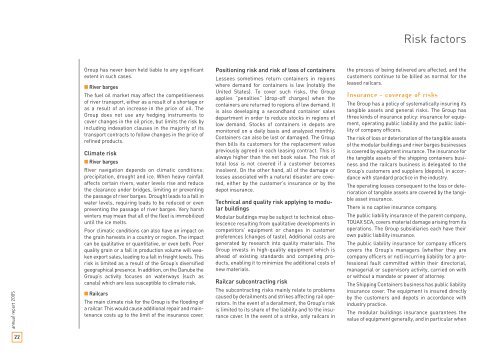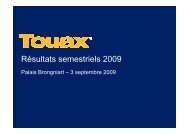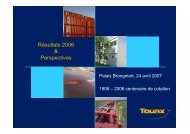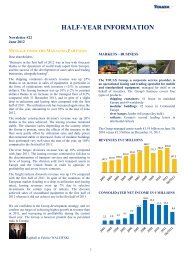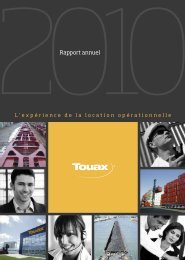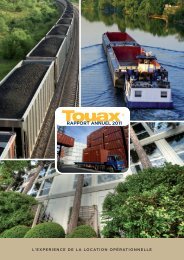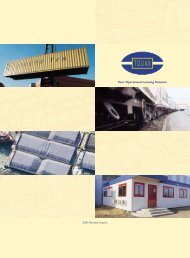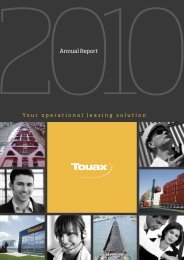2005 Annual Report - Touax
2005 Annual Report - Touax
2005 Annual Report - Touax
Create successful ePaper yourself
Turn your PDF publications into a flip-book with our unique Google optimized e-Paper software.
Risk factors<br />
annual report <strong>2005</strong><br />
Group has never been held liable to any significant<br />
extent in such cases.<br />
■ River barges<br />
The fuel oil market may affect the competitiveness<br />
of river transport, either as a result of a shortage or<br />
as a result of an increase in the price of oil. The<br />
Group does not use any hedging instruments to<br />
cover changes in the oil price, but limits the risk by<br />
including indexation clauses in the majority of its<br />
transport contracts to follow changes in the price of<br />
refined products.<br />
Climate risk<br />
■ River barges<br />
River navigation depends on climatic conditions:<br />
precipitation, drought and ice. When heavy rainfall<br />
affects certain rivers, water levels rise and reduce<br />
the clearance under bridges, limiting or preventing<br />
the passage of river barges. Drought leads to a fall in<br />
water levels, requiring loads to be reduced or even<br />
preventing the passage of river barges. Very harsh<br />
winters may mean that all of the fleet is immobilized<br />
until the ice melts.<br />
Poor climatic conditions can also have an impact on<br />
the grain harvests in a country or region. The impact<br />
can be qualitative or quantitative, or even both. Poor<br />
quality grain or a fall in production volume will weaken<br />
export sales, leading to a fall in freight levels. This<br />
risk is limited as a result of the Group’s diversified<br />
geographical presence. In addition, on the Danube the<br />
Group’s activity focuses on waterways (such as<br />
canals) which are less susceptible to climate risk.<br />
■ Railcars<br />
The main climate risk for the Group is the flooding of<br />
a railcar. This would cause additional repair and maintenance<br />
costs up to the limit of the insurance cover.<br />
Positioning risk and risk of loss of containers<br />
Lessees sometimes return containers in regions<br />
where demand for containers is low (notably the<br />
United States). To cover such risks, the Group<br />
applies “penalties” (drop-off charges) when the<br />
containers are returned to regions of low demand. It<br />
is also developing a secondhand container sales<br />
department in order to reduce stocks in regions of<br />
low demand. Stocks of containers in depots are<br />
monitored on a daily basis and analyzed monthly.<br />
Containers can also be lost or damaged. The Group<br />
then bills its customers for the replacement value<br />
previously agreed in each leasing contract. This is<br />
always higher than the net book value. The risk of<br />
total loss is not covered if a customer becomes<br />
insolvent. On the other hand, all of the damage or<br />
losses associated with a natural disaster are covered,<br />
either by the customer’s insurance or by the<br />
depot insurance.<br />
Technical and quality risk applying to modular<br />
buildings<br />
Modular buildings may be subject to technical obsolescence<br />
resulting from qualitative developments in<br />
competitors’ equipment or changes in customer<br />
preferences (changes of taste). Additional costs are<br />
generated by research into quality materials. The<br />
Group invests in high-quality equipment which is<br />
ahead of existing standards and competing products,<br />
enabling it to minimize the additional costs of<br />
new materials.<br />
Railcar subcontracting risk<br />
The subcontracting risks mainly relate to problems<br />
caused by derailments and strikes affecting rail operators.<br />
In the event of a derailment, the Group’s risk<br />
is limited to its share of the liability and to the insurance<br />
cover. In the event of a strike, only railcars in<br />
the process of being delivered are affected, and the<br />
customers continue to be billed as normal for the<br />
leased railcars.<br />
Insurance – coverage of risks<br />
The Group has a policy of systematically insuring its<br />
tangible assets and general risks. The Group has<br />
three kinds of insurance policy: insurance for equipment,<br />
operating public liability and the public liability<br />
of company officers.<br />
The risk of loss or deterioration of the tangible assets<br />
of the modular buildings and river barges businesses<br />
is covered by equipment insurance. The insurance for<br />
the tangible assets of the shipping containers business<br />
and the railcars business is delegated to the<br />
Group’s customers and suppliers (depots), in accordance<br />
with standard practice in the industry.<br />
The operating losses consequent to the loss or deterioration<br />
of tangible assets are covered by the tangible<br />
asset insurance.<br />
There is no captive insurance company.<br />
The public liability insurance of the parent company,<br />
TOUAX SCA, covers material damage arising from its<br />
operations. The Group subsidiaries each have their<br />
own public liability insurance.<br />
The public liability insurance for company officers<br />
covers the Group’s managers (whether they are<br />
company officers or not) incurring liability for a professional<br />
fault committed within their directorial,<br />
managerial or supervisory activity, carried on with<br />
or without a mandate or power of attorney.<br />
The Shipping Containers business has public liability<br />
insurance cover. The equipment is insured directly<br />
by the customers and depots in accordance with<br />
industry practice.<br />
The modular buildings insurance guarantees the<br />
value of equipment generally, and in particular when<br />
22


